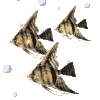|
Scientific Name: Mikrogeophagus altispinosus
Common Name: Bolivian Ram
Synonyms: Crenicara altispinosa, Papiliochromis altispinosus, Microgeophagus altispinosus, and apparently Clown Ruby Cichlids
as well
Order: Perciformes
Class: Actinopterygii
Family: Cichlidae
Subfamily: Geophaginae
Etymology: Haseman, 1911
Origin: Guaporé River and Mamoré River
Distribution: Bolivia and north Brazil
Size: 7.5 cm / 3 inches
Diet: Omnivorous: flakes, tablets, dried, crumbles. Feed live or frozen to improve colour.
Lifespan: 3-5 years
Sexual dimorphism: Females have a redish belly; males have elongated second and third dorsal rays as well as more pointed
dorsal fin.
Swimming level: All.
Minimum Tank Size: 10 gal for a pair. 20+ gal for more.
Females:males ratio: 1:1 sexed pairs or more females then males.
Tank Setup: Planted.
Min / Max number in tank: Can be kept on their own, but better to keep a minimum of a pair. There is no upper limit provided
the tank is large enough for each pair to have a territory of at least 45-60cm in diameter.
Water parameters:
* Water Type: Tropical freshwater.
* Temp: 21 – 28°C
* pH: 6.5 - 8.0
* Hardness: Soft water to medium.
Temperament: Peaceful, but territorial when breeding.
Compatibility: Any smaller sized fish. Avoid overly flowing fins and boistrous companions. If breeding avoid cories, cats
and loaches who will prey on the eggs at night.
Breeding: Egg-depositors. Once a pair is formed, they will then chose a spawning site usually in the form of a stone with
a diameter of at least 10cm. When this is cleaned and the pair will spawn, the female will lay the eggs and the male will
fertilize them a few seconds later. The pair will them guard the eggs (one of the parents will usually be within 5cm of them
while the other will be guarding the area and looking for food). Once the fry hatch, their parents will continue protecting
them untill they will be able to fend for themselves. During this time, the pair will move their offspring to different parts
of the tank and might dig pits for them in the sandy substrate.
The eggs take 48-76 hours to hatch, after which time they take on a "larvae" form where the fry are no longer
eggs, but they are unable to swim. A few days later, they start "hopping" and are after finally able to swim. All
in all, this tansition take 5-7 days.
This species simmilar to Mikrogeophagus ramirezi but are in fact much hardier and more suited to life in UK because of
their tollerance of harder water. As with the Rams, they are also available from many sources so you should chose carefully,
but unlike the Rams, there are fewer commercially bred colour morphs or forms out there.

Text by Kittykat, picture by Kev of allfishforums.
|

